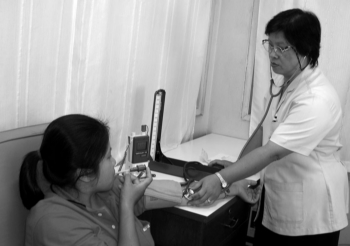TREAT Asia Site Profile: The Research Institute for Health Sciences at Chiang Mai University, Chiang Mai, Thailand
October 2006—The northern Thai city of Chiang Mai lies midway between Myanmar and Laos, not far south of the Golden Triangle—notorious heart of the drug trafficking business in Southeast Asia. As the epidemic of HIV/AIDS has unfolded in Thailand over the last two decades, intravenous drug use has proven to be one of the disease’s most powerful vectors, and at the Research Institute for Health Sciences (RIHES) at Chiang Mai University, the fight against injecting drug addiction and HIV/AIDS goes hand in hand.
The first case of HIV/AIDS in Thailand was reported in 1984, and by the early 1990s the epidemic had firmly established itself in Chiang Mai and throughout much of the country. Spiking in the mid-1990s, HIV/AIDS was confronted aggressively by a partnership between the public sector, private interests, and civil society.

An HIV/AIDS health-care worker checks the vital signs of a patient at the Research Institute for Health Sciences in Chiang Mai, Thailand. (Photo: RIHS) |
Today, Thailand is often cited for the remarkable success of its anti-AIDS campaign. Indeed new adult HIV infections totaled just 21,000 in 2003, a huge drop from a high of 143,000 in the mid-1990s. But statistics suggest that infections are once again on the rise, particularly among marginalized communities such as injecting drug users (IDUs) and men who have sex with men.
“The epidemic in Thailand, including Chiang Mai, has shifted to young people and IDUs,” said Dr. Thira Sirisanthana, principal investigator and director of RIHES. “The homosexual population is also at risk since little attention is paid by the government.”
Since its creation in 1967, RIHES has focused its efforts on public health issues affecting communities in the Chiang Mai region. The institute has been actively involved in the fight against HIV/AIDS since 1988, when scientists there began monitoring infectious disease markers among blood donors.
RIHES serves as one of three TREAT Asia sites in Thailand, and actively participates in the TREAT Asia Observational Database (TAHOD). With a primary mandate to conduct research—RIHES is ranked as the top biomedical research program in the country by the Thai government—its staff has conducted HIV/AIDS studies drawing participants from Chiang Mai as well as volunteers from ethnic minorities along the borders with Myanmar and Laos.
Research at RIHES includes clinical trials of antiretroviral therapy (ART), HIV vaccines, behavioral interventions, and community-based voluntary counseling programs. Dr. Thira singled out current research on the relationship between HIV/AIDS and heroin addiction, and described studies of the effectiveness of behavioral interventions such as peer education networks in relation to addiction and HIV. RIHES’s research projects are supported by the U.S. National Institute on Drug Abuse and the National Institute of Mental Health, as well as the major HIV/AIDS study networks of the National Institute of Allergy and Infectious Diseases: namely the HIV Prevention Trials Network, the HIV Vaccine Trials Network, the Adult AIDS Clinical Trials Group, and the Pediatric AIDS Clinical Trials Group.
The Chiang Mai institute’s involvement with community advocates and people living with HIV/AIDS extends beyond the research lab. Together with the Infectious Disease Clinic at the Chiang Mai University Medical School, where most of the institute’s researchers hold joint appointments, RIHES doctors operate two outpatient sessions a week, during which they see about 100 patients—more than 5,000 each year.
Patients are offered comprehensive services, including ART, treatment for opportunistic infections, psychosocial support, and other medical and surgical care. The front-line drug regimen is typically GPO-VIR, which is a generic fixed-dose combination of D4T, 3TC, and nevirapine. In Chiang Mai and throughout Thailand, treatment is based almost entirely on generic drugs.
Before the advent of ART, up to 100 AIDS patients were admitted to the hospital each month, reported Dr. Thira; now, admissions are down to between five and ten a month. In Chiang Mai, where ART is generally available, he noted, “The availability of highly active antiretroviral therapy has changed a fatal disease to a chronic ‘treatable’ disease.”
Still, significant challenges confront medical personnel at RIHES, chief among them understaffing. Only three staff physicians at the hospital are on hand to treat adult HIV/AIDS patients, and only two pediatricians are available for children with the disease. In addition, Dr. Thira cited “a big turnover of doctors in government hospitals and a continuing need for education and training.” (New medical graduates are required by law to serve in rural government hospitals for three years, but they usually leave afterwards to pursue postgraduate training or to work in higher paid positions in private hospitals.)
RIHES has played a leading role in HIV/AIDS training through a Thailand/Laos collaboration in which fellows from the neighboring country receive training from RIHES and Chiang Mai University.
With the levels of stigma in Thailand “markedly diminished, although not totally gone,” Dr. Thira praised the Thai government for the struggle it has waged against HIV/AIDS, particularly during the highest prevalence years of the mid-1990s. Still, “the level of support may have decreased lately,” he noted, perhaps “because of the illusion that the country has been ‘successful’ in combating HIV/AIDS. But the virus is still a big public health problem for Thailand.”